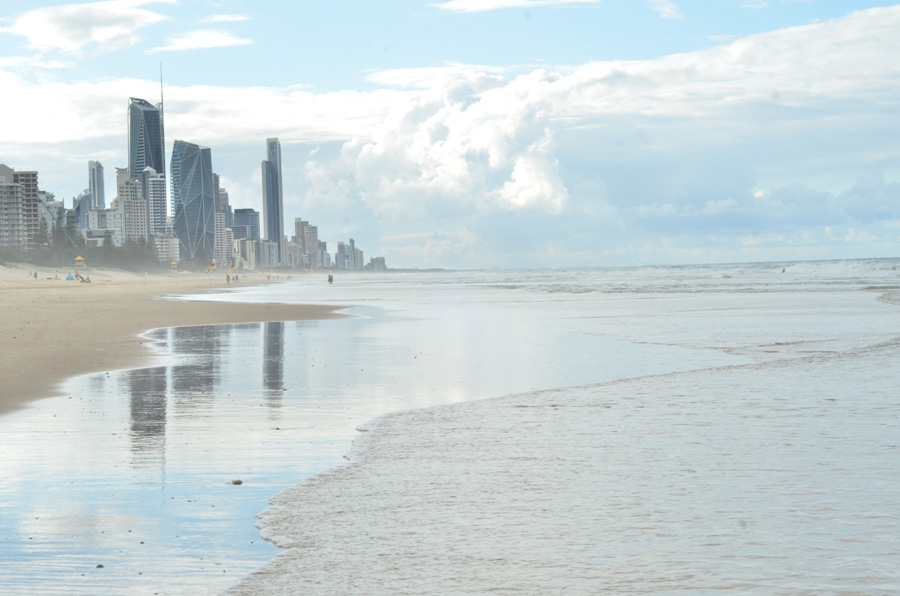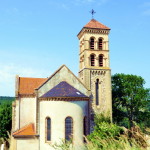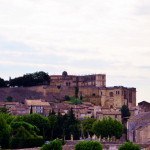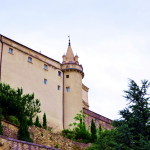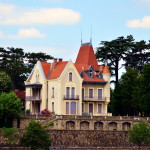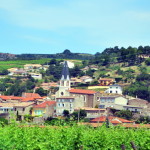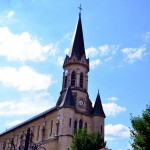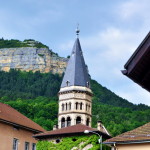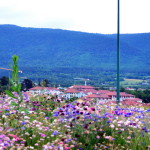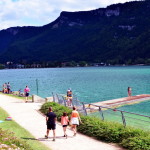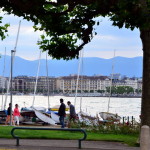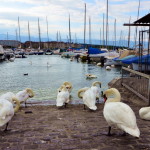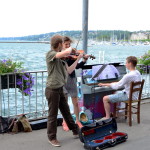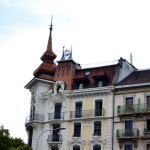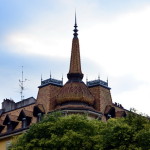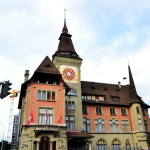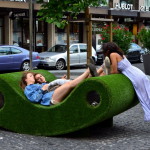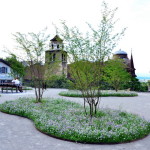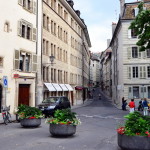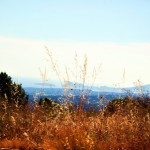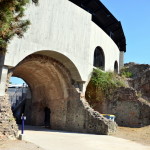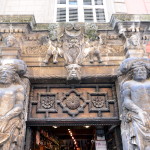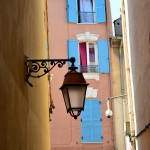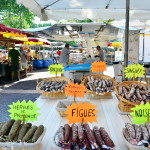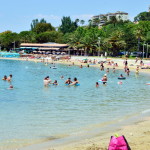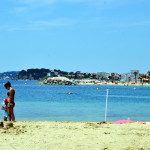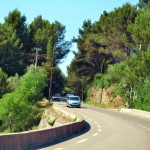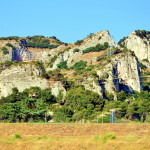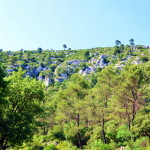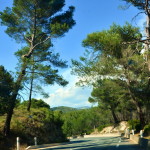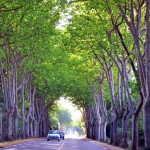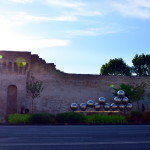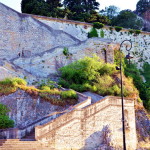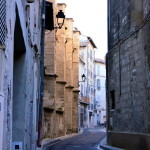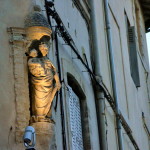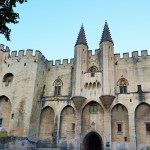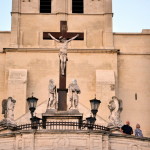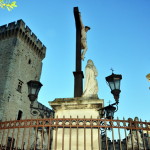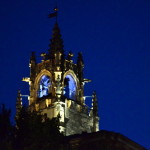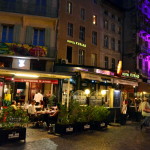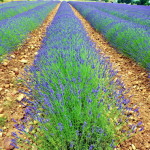 Leaving Provence on the way to Switzerland, it was impossible to
Leaving Provence on the way to Switzerland, it was impossible to 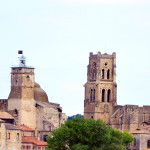 miss the beautiful lavender fields. We stopped the car along the road and I jumped over a ditch to run among the violet-blue fragrant lavender. A few sprigs of lavender were plucked and put them on the dashboard of the car. If you believe the ancient Romans, the smell of lavender fills the human heart with joy and confidence. The joy in my heart was very much there, not only from the lavender, but also from seeing the many fields of Garlic which abound all around this area.
miss the beautiful lavender fields. We stopped the car along the road and I jumped over a ditch to run among the violet-blue fragrant lavender. A few sprigs of lavender were plucked and put them on the dashboard of the car. If you believe the ancient Romans, the smell of lavender fills the human heart with joy and confidence. The joy in my heart was very much there, not only from the lavender, but also from seeing the many fields of Garlic which abound all around this area.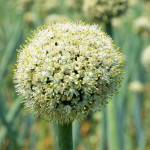
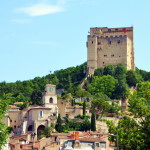 These wonderful plantations were gradually replaced by the green hills of Rhone as we drove past the town of Crest, surmounted by one of the highest keeps in Europe, The Tour de Crest, as it is known, is 52 meters in height. In 1120 the Chateau of Crest in this medieval town was named after Arnaud de Crest the
These wonderful plantations were gradually replaced by the green hills of Rhone as we drove past the town of Crest, surmounted by one of the highest keeps in Europe, The Tour de Crest, as it is known, is 52 meters in height. In 1120 the Chateau of Crest in this medieval town was named after Arnaud de Crest the 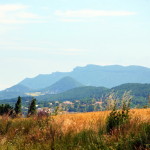 Lord and master who lived there. In the Middle Ages European nobility use to build fortified towers named Donjon within their castles. In 1394 Cardinal Richelieu destroyed this Chateau leaving only the Donjon. You can see the Tour de Crest from the road sticking out above the red roofs of the town as you drive past. We also noticed that red roofs are mostly seen in the southern villages of France, in contrast to the gray-blue roofs in the north.
Lord and master who lived there. In the Middle Ages European nobility use to build fortified towers named Donjon within their castles. In 1394 Cardinal Richelieu destroyed this Chateau leaving only the Donjon. You can see the Tour de Crest from the road sticking out above the red roofs of the town as you drive past. We also noticed that red roofs are mostly seen in the southern villages of France, in contrast to the gray-blue roofs in the north.
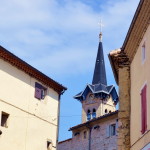 Next we passed the City of Valence, which is the conventional
Next we passed the City of Valence, which is the conventional 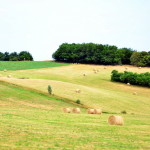 boundary between the north and south of France. Valence was founded by the Romans in the Narbonne Gall area on the rocky banks of the Rhone River at the crossroads, leading to the Azure coast. In the 15th century AD, Valence passed under the authority of King Louis XI and was ruled by the Duke of Valentinois. This title is still claimed by the Sovereigns of Monaco.
boundary between the north and south of France. Valence was founded by the Romans in the Narbonne Gall area on the rocky banks of the Rhone River at the crossroads, leading to the Azure coast. In the 15th century AD, Valence passed under the authority of King Louis XI and was ruled by the Duke of Valentinois. This title is still claimed by the Sovereigns of Monaco.
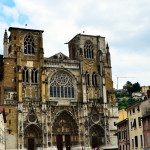 Two more cities are on the banks of the River Rhone in the Rhone-Alpes region, Vienne and Lyon, which were also inhabited by Gallic tribes in ancient times. Vienne was one of the major cities of Gaul in antiquity. According to legend, Pontius Pilate was exiled to Vienne after the death of Jesus Christ and his tomb is on the site of a Roman pyramid in the city.
Two more cities are on the banks of the River Rhone in the Rhone-Alpes region, Vienne and Lyon, which were also inhabited by Gallic tribes in ancient times. Vienne was one of the major cities of Gaul in antiquity. According to legend, Pontius Pilate was exiled to Vienne after the death of Jesus Christ and his tomb is on the site of a Roman pyramid in the city.
Lyon on the other hand, is more than 2000 years old and partly thanks to its convenient location at the convergence of two navigable rivers was named the capital of Gaul. Also, two famous Roman emperors were born in this city, Claudius and Caracalla. Today, the archbishop of Lyon is still referred to as “Primat des Gaules” and the city is often referred to as the “capitale des Gaules“. The Roman Emperor Nero lived here too and Lyon was also the first city in Europe to be known for the production of silk. Today Lyon is the second largest city in France and famous as the gourmet capital of the world.
It took less than two hours by car from Lyon to Geneva and it was a most enjoyable part of our journey that day. The road climbs higher and higher into the French Alps surrounded by lush green valleys and mountain lakes, where some of the most popular winter ski resorts are situated.
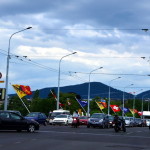 Most of Switzerland is founded on the Alp Mountains and the city of
Most of Switzerland is founded on the Alp Mountains and the city of 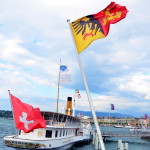 Geneva is located at an altitude of 373 meters above sea level. 2000 years ago there was a Celtic settlement on the site of this city. One of it’s main attractions is Lake Geneva, surrounded by mountains on all sides with a huge fountain in part of the lake shooting up 140 meters into the air making the city different from others. It is one of the largest fountains in the world built in 1886 as part of the hydraulic system of the city. The fountain works every day and is only switched off in cold and windy conditions. We were unlucky that day as there was a very strong wind so on my photos, although there is no fountain, you can see the unique landscape with the crystal clear waters of the lake without any spray from the fountain.
Geneva is located at an altitude of 373 meters above sea level. 2000 years ago there was a Celtic settlement on the site of this city. One of it’s main attractions is Lake Geneva, surrounded by mountains on all sides with a huge fountain in part of the lake shooting up 140 meters into the air making the city different from others. It is one of the largest fountains in the world built in 1886 as part of the hydraulic system of the city. The fountain works every day and is only switched off in cold and windy conditions. We were unlucky that day as there was a very strong wind so on my photos, although there is no fountain, you can see the unique landscape with the crystal clear waters of the lake without any spray from the fountain.
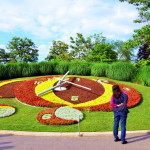 Not only are Swiss watches a guarantee of quality but you can also
Not only are Swiss watches a guarantee of quality but you can also 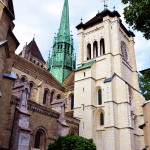 check the time in Geneva by the flower clock laid out in what is known as the English Garden. Swedish naturalist Carl Linnaeus when creating the project in 1903 used the natural biorhythms of plants so they would bloom at a particular time according to their biological clocks. 60 years ago the clock was updated and now the flowers are planted in beds according to their season.
check the time in Geneva by the flower clock laid out in what is known as the English Garden. Swedish naturalist Carl Linnaeus when creating the project in 1903 used the natural biorhythms of plants so they would bloom at a particular time according to their biological clocks. 60 years ago the clock was updated and now the flowers are planted in beds according to their season.
Another famous attraction of this city is the Basilica of St. Peter from the 12th century which has been rebuilt and refurbished many times and combines several styles, including, Baroque, Romanesque, Classicism and the Gothic. The eclectic architecture of the cathedral makes it very unique. In addition, Calvinism was born in this Cathedral, which changed the beliefs of some people around the world. Reformer John Calvin preached here and a wooden chair used by him is preserved in the church.
Geneva on Sunday evening is a very quiet and deserted place one can hardly find a nice cafe or restaurant except for MacDonald’s and Starbucks, which was very upsetting. We spent most of our time admiring the hundreds of spires on the rooftops, always positioned in prominent places on the corners of buildings. The silence was suddenly broken by a car procession of football fans waving flags and beeping of car horns announcing the victory of the national team at a football match in Brazil during the time of the world cup.
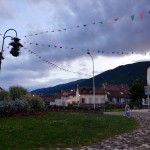
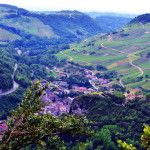 The road from Geneva to Dijon was also quiet and deserted, with 40 km of winding hairpin turns in the twilight of the Alps. Empty villages and streets on the way gave us hope that we may find room in a roadside hotel. But all the hotels were occupied so we decided to drive on. As we were approaching Dijon, we had the biggest fright of the whole trip when one of our tires hit something on the road and exploded sending the car into a whirlwind skid. My next story will be about that night and our day in Dijon.
The road from Geneva to Dijon was also quiet and deserted, with 40 km of winding hairpin turns in the twilight of the Alps. Empty villages and streets on the way gave us hope that we may find room in a roadside hotel. But all the hotels were occupied so we decided to drive on. As we were approaching Dijon, we had the biggest fright of the whole trip when one of our tires hit something on the road and exploded sending the car into a whirlwind skid. My next story will be about that night and our day in Dijon.
